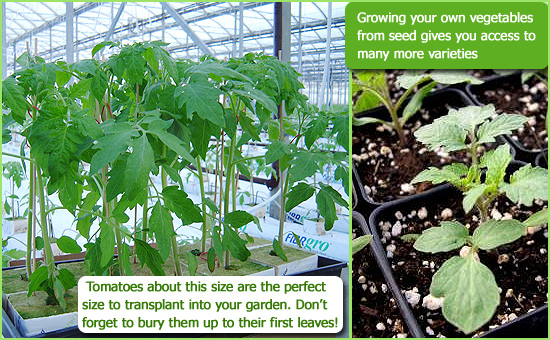Choosing Seeds or Plants to Start Your New England Vegetable Garden... The Good, The Bad and The Delicious
Last Updated:
Not many things will stir up a bunch of New England gardeners like the topic of choosing to start your vegetable garden from seeds or buy pre-grown seedlings. It can make a hornet's nest look tame!
The purists will tell you how they've managed to collect seeds from their crops every year for the past 20 years and use them for seed-starting each Spring. Their claim- better seeds make better plants, and the more local the seed, the hardier and productive the plants. Then there's the rest of us, who rush to the big box garden center on Memorial Day weekend, load up on 1-2 foot tomato plants, squash, cucumbers and the like, and head home to plop them in the ground and call it a day.
As with most things, the real solution lies in a mixture of the two. There are a number of vegetables that will benefit from a head start if using seed, like the all-mighty tomato. Seasoned vets start their seeds in April, 8-10 weeks before putting them out in the garden. Tomatoes are a warm-weather loving vegetable, and won't do a heck of a lot of anything in your New England garden if the temperature is lower than 60 degrees at night.

TOMATO PLANT BUYING TIP: New England garden centers offer larger tomato plants, usually with tomatoes already on the vine for a LOT more than you'll pay for a 6-pack of 12 inch plants. Don't buy them, they are not only overpriced, but a month after you plant both of them side by side the smaller ones will catch up and be about the same size!
The benefit to starting your tomatoes from seed: CLEARLY, you will have access to an incredible variety of tomatoes, including sweet and juicy heirloom varieties dating to the 1800's, Black Krim tomatoes that are a deep burgundy color and countless cherry and pear varieties. Yes, you have to babysit them a little during the sprouting process but boy are they worth it! If you decide to hit the garden center instead, that's ok too. Just make sure you pick plants that are about 12 inches tall that have all green leaves and don't look like they've spent the past week crossing the desert.
Whatever you choose to do for the slow-starting vegetables like green peppers, onions, broccoli, tomatoes and certain herbs, we strongly recommend that you start your cucumbers, squash, pumpkins, beans and peas BY SEED. All of these vegetables sprout in less than a week when planted right in the garden after all danger of frost. Buying these plants at a garden center is a colossal waste of money. You can buy a seed packet with more seeds than you'll use in a season for less than a couple of bucks and you can use the leftover seeds next year. Most people don't realize seeds are good sometimes for up to 5 years after they've been packaged. And the best part... YOU get to choose the variety, not some commercial grower.
So get started now and check out seed catalogs like Burpee, John Scheeper's (one of our picks for interesting varieties of veggies) or another good standby Gurney's. You'll have the seeds in less than 10 days and you can start planting right away!